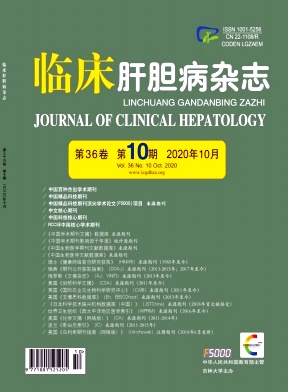|
[1] Global Burden of Disease Cancer Collaboration,FITZMAURICE C,ABATE D,et al. Global,regional,and national cancer incidence,mortality,years of life lost,years lived with disability,and disability-adjusted life-years for 29 cancer groups,1990 to2017:A systematic analysis for the global burden of disease study[J]. JAMA Oncol,2019,5(12):1749-1768.
|
|
[2] BRAY F,FERLAY J,SOERJOMATARAM I,et al. Global cancer statistics 2018:GLOBOCAN estimates of incidence and mortality worldwide for 36 cancers in 185 countries[J]. CA Cancer J Clin,2018,68(6):394-424.
|
|
[3] CHEN YD,MO CM,RONG Z,et al. Research Advance of Traditional Chinese Medicine Combined Transcatheter Arterial Chemoembolization(TACE)in Treating Primary Hepatic Carcinoma[J]. J Liaoning Univ Tradit Chin Med,2019,21(1):87-90.(in Chinese)陈亚栋,莫春梅,荣震,等.中药联合肝动脉栓塞化疗术(TACE)治疗原发性肝癌研究进展[J].辽宁中医药大学学报,2019,21(1):87-90.
|
|
[4] CHEN XY. Effect of Fuhe Beihua Decoction on T-lymphocyte subsets and NK cells after chemoembolization for primary liver cance[D]. Nanjing:Guangxi University of Chinese Medicine,2016.(in Chinese)陈小云.敷和备化方对原发性肝癌化疗栓塞术后T淋巴细胞亚群及NK细胞的影响[D].南宁:广西中医药大学,2016.
|
|
[5] National Health and Family Planning Commission of the People’s Republic of China. Diagnosis,management,and treatment of hepatocellular carcinoma(V2017)[J]. J Clin Hepatol,2017,33(8):1419-1431.(in Chinese)中华人民共和国国家卫生和计划生育委员会.原发性肝癌诊疗规范(2017年版)[J].临床肝胆病杂志,2017,33(8):1419-1431.
|
|
[6] LIN HS. Guidelines for traditional chinese medicine diagnosis and treatment of malignant tumors(2014 edition)[M]. Beijing:People’s Medical Publishing House,2014:372-400.(in Chinese)林洪生.恶性肿瘤中医诊疗指南(2014版)[M].北京:人民卫生出版社,2014:372-400.
|
|
[7] ZHANG Q,LI HP. Clinical analysis of TACE combined with RFA in treating primary liver cancers of high-risk sites[J/CD]. Chin J Oper Proc Gen Surg(Electronic Version),2020,14(2):201-204.(in Chinese)张强,李恒平.TACE术联合RFA术对高危部位原发性肝癌的临床疗效分析[J/CD].中华普外科手术学杂志(电子版),2020,14(2):201-204.
|
|
[8] XU W,LI GF,LI Q,et al. New clinical advances in tumor heterogeneity of hepatocellular carcinoma[J]. J Hepatopancreatobiliary Surg,2016,28(1):84-86.(in Chinese)徐伟,李高峰,李权,等.肝癌肿瘤异质性的临床新进展[J].肝胆胰外科杂志,2016,28(1):84-86.
|
|
[9] CHANG QQ,PENG Y,WANG GJ,et al. Clinical research progress of small molecule tyrosine kinase inhibitors as antihepatocellular carcinoma agents[J]. Chin J Clin Pharmacol Ther,2019,24(8):948-956.(in Chinese)常青青,彭英,王广基,等.抗肝癌小分子酪氨酸激酶抑制剂的临床研究进展[J].中国临床药理学与治疗学,2019,24(8):948-956.
|
|
[10] ZHAO BK,HE L,WU ZT,et al. Clinical efficacy of a regimen containing retetrexed in the treatment of advanced hepatocellular carcinoma by TACE[J/OL]. J Chin Oncol. http://kns.cnki. net/kcms/detail/33. 1266. R. 20200228. 1135. 018. html.(in Chinese)赵宝魁,贺莉,吴泽涛,等.含雷替曲塞方案经TACE治疗中晚期肝癌的临床疗效[J/OL].肿瘤学杂志.http://kns. cnki. net/kcms/detail/33. 1266. R. 20200228. 1135. 018. html.
|
|
[11] CHEN H,MAO JP. The research progress on tumor immune escape built in relations of tumor and T lymphocytes[J]. China Biotechnol,2012,32(10):86-92.(in Chinese)陈海,毛建平.肿瘤免疫逃逸与T淋巴细胞关系的研究进展[J].中国生物工程杂志,2012,32(10):86-92.
|
|
[12] ZHU Y,QIN LX. Recent progress of biological immunotherapy for hepatocellular carcinoma[J]. Chin J Pract Surg,2016,36(6):636-640.(in Chinese)朱迎,钦伦秀.肝癌免疫生物治疗的现状及评价[J].中国实用外科杂志,2016,36(6):636-640.
|
|
[13] WAN H,ZHANG XX. Progress in immunotherapy for T-lymphocyte-associated tumors[J]. China Pharmacy,2017,28(20):2872-2876.(in Chinese)万红,张晓旭.T淋巴细胞相关肿瘤免疫疗法的研究进展[J].中国药房,2017,28(20):2872-2876.
|
|
[14] WANG LJ,MIAO TG,NING GX,et al. The influence of TACE on T lymphocyte subsets in patients with primary liver cancer[J]. J Intervent Radiol,2015,24(2):165-168.(in Chinese)王立静,苗同国,宁更献,等.肝动脉化疗栓塞术对原发性肝癌患者T淋巴细胞亚群的影响[J].介入放射学杂志,2015,24(2):165-168.
|
|
[15] DING H,WANG J,WANG ZG,et al. Clinical effectiveness of cantharidin-containing Chinese medicine preparations on immune function in patients with hepatocellular cancer:A metaanalysis[J]. J Oncol Chin Med,2020,2(1):85-91.(in Chinese)丁皓,王婧,王志刚,等.含斑蝥素中药制剂对肝癌患者免疫功能影响的Meta分析[J].中医肿瘤学杂志,2020,2(1):85-91.
|
|
[16] HE S,LIAO ZX. Research progress on the mechanism of traditional Chinese medicine in the treatment of hepatocellular carcinoma[J]. Chin Tradit Patent Med,2017,39(1):155-160.(in Chinese)贺珊,廖长秀.中药治疗肝癌机制的研究进展[J].中成药,2017,39(1):155-160.
|
|
[17] HUANG RR,QIAN Y,XIANG M. Advances in immunomodulatory effects of ginsenoside Rh2[J]. Chin J Immunol,2019,35(23):2936-2941.(in Chinese)黄容容,钱颖,向明.人参皂苷Rh2免疫调节作用研究进展[J].中国免疫学杂志,2019,35(23):2936-2941.
|
|
[18] XIAO Y,WU ZP,JIN CG. Inhibitory effect of ethanol extract of Oldenlandia Diffusa on colorectal cancer angiogenesis in BALB/c mice[J]. J Kunming Med Univ,2013,34(10):53-57.(in Chinese)肖云,伍治平,金从国.白花蛇舌草提取物抗小鼠结直肠癌血管生成的实验研究[J].昆明医科大学学报,2013,34(10):53-57.
|
|
[19] REN ZJ. Matrine induces autophagy in human hepatoma HepG2cells through m TOR signaling pathway[D]. Lanzhou:Lanzhou University,2011:7-9.(in Chinese)任志俭.苦参碱通过m TOR信号通路诱导人肝癌HepG2细胞发生自噬现象[D].兰州:兰州大学,2011:7-9.
|














 DownLoad:
DownLoad: